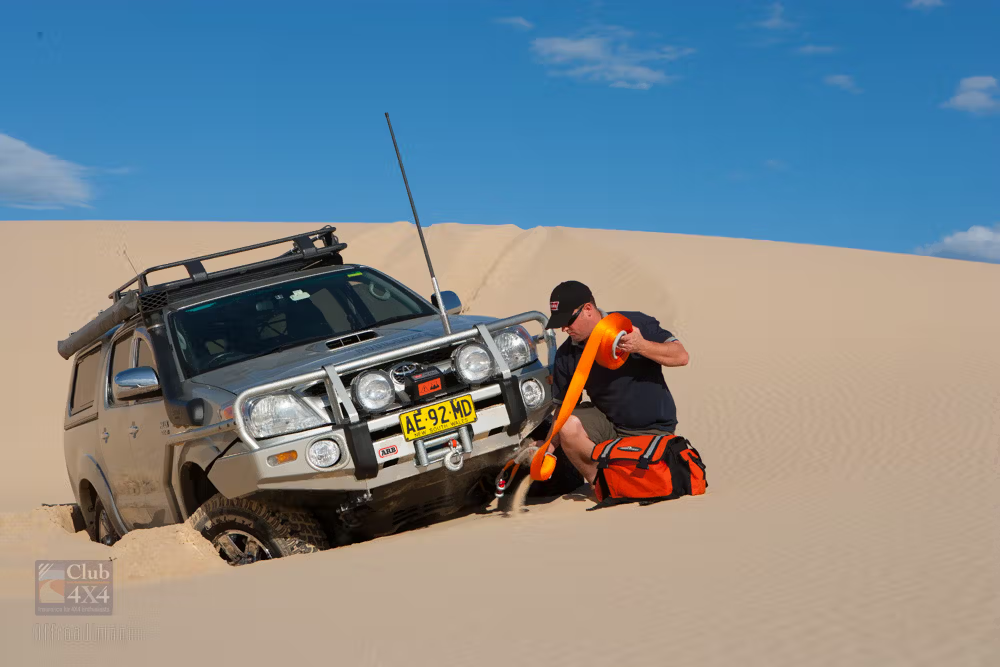We have just jumped into a brand-new year, and I am sure that plenty of you have created a “New Year’s Resolution”. Get fit, lose weight, spend more time with family, etc.
Have you taken time to figure out preparation around your next and future trips off-road?

I believe that we should all have a good look at our basic, yet essential items, that we carry in our 4WD and maybe do a late addition to your New Year’s Resolution to have your 4WD better prepared for any trip off road, anytime.
Of course, there are the obvious things that every 4WD should carry when on a trip. A good First Aid Kit, drinking water, food and other supplies, tools and spare filters, a tyre repair kit and compressor etc.

But what about recovery gear?
Now the first thing we need to think about is how a trip can change. You might be heading out on a simple trip to a local lake and not even consider heading off road. If you are anything like us, you might look at every dirt road you travel past thinking, I wonder what’s up there. So, a simple trip on a bitumen road can change quite quickly to a day of discovery heading along an amazing new track in search of… well anything really.

We carry a basic kit always, wherever we travel. This basic kit is always in our 4WD tucked away just in case we might need it. We hopefully won’t need it for ourselves, but it’s amazing how many times we have needed to help someone else stuck whilst out on a track somewhere.
There is simply so much awesome recovery gear to choose from, but what do you need in a basic recovery kit?

My pick for a basic recovery kit that every 4WD, from a standard vehicle straight out of the showroom through to a fully set up tourer, is as follows.
- Snatch Strap
- 2 x Shackles or Soft Shackles
- Gloves
- Tyre Deflator
- A set of recovery boards either Treds or Maxtrax (optional)
- A jacking plate
- A long-handled shovel
- A Tree Trunk Protector if you have a winch (optional)
- Recovery dampener
The Snatch Strap is an obvious one and will most likely be one that is used by 4WDers more than any other recovery item available. But you need to be able to attach it to both vehicles rated recovery points so you will need at least one, but maybe a set of shackles. We usually carry two snatch straps and at least two soft shackles, with one living in one of the toolboxes, and the other living under the seat. If you are stuck in a spot where you can’t get access to your rear draws or toolboxes where the recovery gear is stored, the snatch strap stored inside your cabin might be the one you use to help the recovery.

A set of gloves are important to have whenever you are performing recoveries, you might use these to assist in reducing hand damage whilst working with recovery gear, but most importantly, a set of gloves can be utilised to help in road building where moving rocks on a track to place them under the tyres of the stuck vehicle might assist in its forward progress. A set of gloves is extremely important. We usually carry two sets of gloves as you might as well share the love and have a second person help with the exercise. They are also great around camp or whilst changing a tyre.

You might think that a tyre deflator is not a piece of recovery gear, but let me tell you, I have recovered myself and others many times by simply letting the tyres down further to assist in the vehicle’s traction. This is one of the most important tools every 4WDer should carry.

Why have I included recovery boards as an option? Simply put, there are many vehicles which don’t have rated recovery points at both the front and the rear. You might have the intention of adding recovery points to your vehicle build but haven’t sourced them, you might also come across a vehicle which is stuck that doesn’t have a rated recovery point. Recovery boards might be just the thing to help in this situation. An important thing to remember though is that they take up a fair bit of room and whilst there might be many items available to help store them on the outside of your vehicle, if you don’t have this solution, carrying them inside your vehicle will take up quite a lot of space.

Why a jacking plate you might ask? If you are on soft sand, soil or mud, and need to jack up your vehicle, the jack might sink into the surface creating an unsafe situation. Spreading the load by utilizing either a commercially available device or even a piece of timber might help in your efforts. Jacking up a stuck vehicle is hard work but might be the solution to recovering it by safely raising the vehicle up so that you can place items under the tyres, allowing you to travel forward. We carry 4 sections of light timber which when used together create a large pad and a safe jacking platform. These are stored under our rear seat and are used more than you can imagine.

Any item which can be used to “shovel” or clear debris from under a vehicle will help. I have even used a plastic covered clipboard as that was the only thing, I had at the time… (lesson learnt). But a long-handled shovel is my pick of tools. Why a long-handled shovel? The length of the shovel is important in assisting the user to extract sand or mud etc, from under the diffs and centre of the vehicle. The long-handled shovel will give you more reach and this will reduce the time spent in the sticky situation. You can get these in a two-piece design making it easy to store, but ours live on the roof of our vehicle and is a well-used item for both recoveries and around camp.

The tree trunk protector would only be ulitised if you have a winch but is essential if you want to use a tree to winch from. We carry one of these always and know that this will provide us a safe recovery whilst protecting the tree we are recovering off.

A recovery dampener is a must when performing any winching or snatch recoveries. This will reduce the hazards in the event of a strap or cable failure and will hopefully assist in pulling the failed item to the ground. If you don’t have a recovery dampener, you could use the soft recovery bag or an old jacket or towel. Whatever you can place over the strap or cable will help.

Now I know that this list doesn’t include everything as this is a basic list. But at the same time, there is a lot in this list. We will discuss in a future article what you need to consider for an advanced recovery kit ready for that big adventure.
Are you ready for anything this year?

“Cheers”
-Michael Ellem
Offroad Images

The Campfire – Feedback
Just like sitting around the campfire, we would love to hear what you have to say. You can be involved simply by entering your comments below.
Also… we will be featuring stories about photography tips and tricks, 4X4 preparation, build planning and maintenance, as well as featuring inspirational locations for you to visit in your 4X4. So please get involved and let us know what you’d like to hear about. If you have any requests for stories to be featured in campfire or would like to provide feedback about this article, please send us a message on our social links:
Instagram: @offroadimages
Facebook: @offroadimages
YouTube: youtube.com/OffroadImages
Website: www.offroadimages.com.au
As 4X4 enthusiasts who live for the opportunity to create awesome imagery anywhere in Australia, we know that our vehicle assets are covered wherever we travel to create that shot, as we are insured by Club 4X4.


